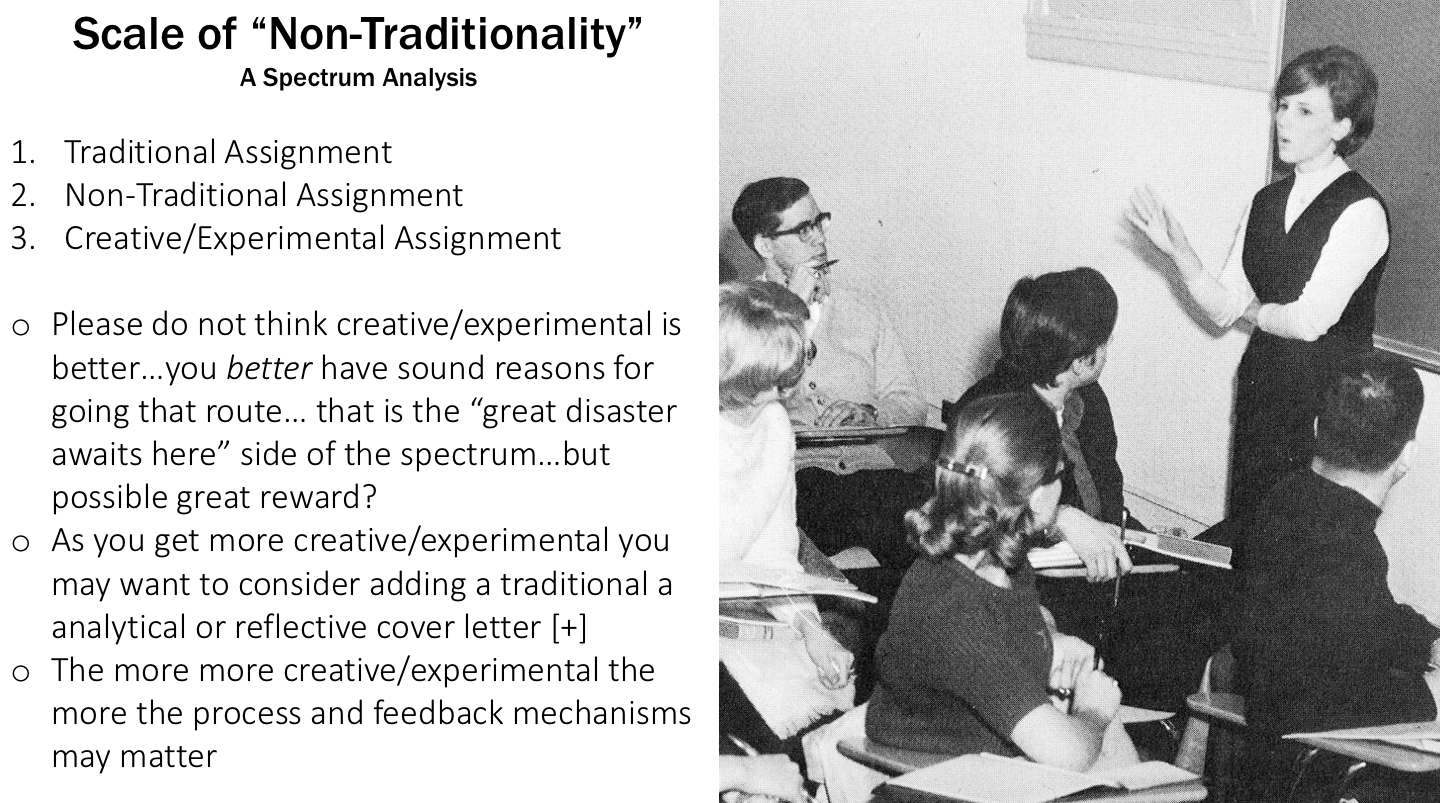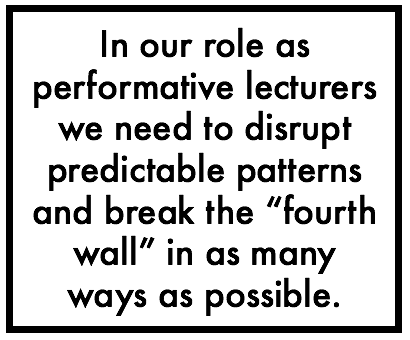As instructors, we somtimes feel the temptation to spice up our coursework. We may feel a bolt of jealousy, for example, when we hear a colleague’s idea for a brand new approach to an old-school assignment (I’m looking at you, humdrum 10-page research paper). While reflection and refinement should be the standard to which we inspire, we should not seek novelty simply for novelty’s sake.
When seeking to craft a non-traditional assignment, we should be guided by our core educational goals, many of which cluster around critical thinking and thoughtful creativity. By foregrounding these goals it’s possible to conceive of new ways we can express our interests or student passions. In other words, the search for non-traditional assignments should be in service to expressing “traditional” education goals in new ways. Specifically, in ways that appropriately reflect our course content, student skill sets and interests, or general teaching philosophy.
I should note, it is also far easier to integrate a non-traditional assignment into a course when that course is designed “backwards.” By starting with and thinking through the learning outcomes we can more easily conceptualize the myriad ways in which they can be actualized. In contrast, if you start by thinking through all of the assigned readings written by scholar for scholars, it’s pretty natural to envision all student assignments in the same fashion, i.e. as variants of scholarly writing. Indeed, one of the first limitations you may run into with “backwards design” is that all of those scholarly monographs you assigned just do not work and need to be trashed mindfully returned to their bookshelves. (I apologize to the international cartel of scholars, please do not put cyanide in my afternoon tea. You weren’t getting any royalties from your book sales anyway…[1])
If you are not undeterred, below I offer several of the slides I presented for a non-traditional assignments workshop organized by my university’s Summer Teaching Institute for Associates program. I will also provide commentary to the slides. This workshop was far more “workshoppy” than my previous ones, thus there is much on my handout that is not covered in my slides. [NonTrad Workshop Handout]
We began the workshop by discussing the reasons why instructors might seek out non-traditional assignments. I tried to focus on the fact that traditional university research papers are a very specific genre that most students will not use later in their life. In addition, we may also recognize that this genre does not adequately reflect the goals or “spirit” of our courses. Accordingly, we might open up to the possibility that there are other modes and media more reflective of student interests, skills, and real-world needs that still ask them to engage the critical skills we value.



A limitation of my workshop was the presumption I held for what a “traditional” assignment embodied – this is not the same across disciplines. In planning this workshop I decided to use my disciplinary expertise (as a historian of religious studies) as the norm which often assigns a printed paper meant to inform or persuade a well-informed (scholarly) audience. This is an assignmentt type that certainly resonates across much of the humanities.[2]
By highlighting the various rhetorical elements of genre, purpose, audience, and medium, I suggested during the workshop that the alteration of any of these aspects constituted a move towards non-traditional assessment.

Before we moved on to discussing how we might alter each of these four variables, I suggested that a non-traditional assignment could also verge on becoming “creative” or even “experimental,” a side of the assignment spectrum that should be approached with care. I suppose I cannot dislodge the traditionalist voice ringing in my head (I am a historian of religious studies), but I suggested that truly creative or experimental assignments be paired with a more traditional writing assignment, like a cover letter offering an analysis of the assignment through the lens of course concepts or a reflection on the process of creating it (really, reflection is a good idea with any assignment). Fundamentally, this is a concern over evaluation (grading); we have to remain equitable in the assessment of our projects, an issue which arises as they turn more radically away from standard critical writing (this is discussed more on the handout). Additionally, I argued that more focus has to be placed on process and discussion as the more creative or experimental the assignment becomes. Feedback, necessary in any assignment, is simply more integral when the students are engaging in genre forms that are unfamiliar to them.

We then moved into a discussion of the variables for crafting assignments (genre, purpose, audience, medium). Considered individually for heuristic purposes, these elements are actually closely interrelated. For example, changing just one of the variables may be enough to inspire a wholesale shift in the other three. As we discussed these variables, I had the participants fill out the four-field “matrix” on the handout as new ideas came to life.
If I had to give one suggestion, I would say reconceiving the audience functions as a powerful motivation for shifting an entire assignment. Instead of assuming an ill-conceived set of imaginary scholars (or the sole instructor or TA), which new audience could students address armed with their new knowledge? What would an assignment look like if the students had to talk to the general population or to people who held conflicting views on your course materials? What if your students spoke to a local community or to different organizations in your school? Or, perhaps, you could imagine them addressing a historical person or even a living political entity.[3]. Ultimately, the object of this exercise was to let the creative juices flow and sort the pieces afterwards.




The last slide addressed some concerns I felt pertinent to exploring non-traditional work. It foregrounds the facts that many students may not have the required skills, money, or free time to do what you hope (or expect) from them. Student familiarity with or simple access to computer programs or the ability to go to a museum exhibit or performance may be stumbling blocks to some. Some of this could be circumvented with good planning.

The rest of the workshop was devoted to discussing potential ideas and beginning the process of putting those new sparks of insight into words.
Below is a list of potential ideas
- Have students draft a lesson plan (LO & assessment) and lead an activity on a concept for the class
- Have students or instructor create Twitter or Instagram accounts and post regularly on course content (blogs are an “old-school” option)
- Visit your university library archives or special collections and have students select a document or artifact and give a mini-lecture in class
- Analyze the different views and approaches on a course-relevant topic by both a scholarly peer-reviewed article and something written for the public (news article, magazine article, YouTube video, etc…)
- Hold a class poster presentation session (held in the classroom or hallways of your department) and have students comment on one another’s work (written peer-review)
- Have students create a podcast or video on a tricky concept and use as an instructional aid (remember to keep create a catalogue of past work!)
- Have students write in a “popular” genre relevant to course materials (e.g. magazine article, pamphlet, poster, newspaper opinion article, letter to the editor)
- Visit a local site and have students document and analyze their visit or schedule an interview with someone about the site
- Set up a formal class debate about central themes of the course (randomly assign “for” and “against” teams)
- Establish a scenario and have students role play figures central to your course
- Have students craft an annotated bibliography or literature review on complementary aspects to your course
- Have student create a material object relevant to course material (e.g. alter, home shrine, model, etc…)
- Compile a list of available public media on a course theme and evaluate the quality of each item’s content and post the evaluations online
- Create an infographic about a topic or theme, or create a concept map/knowledge map of the course materials
- Have student keep a course journal where they reflect on difficult topics and plan what they will focus on for next lecture/discussion
- Design (/and implement) a collaborative on-campus project
- Have student write a book review of a source read in class
- Have students interview a professor about their current research (or an influential paper)
- Volunteer at a local nonprofit or attend a community meeting or group and write about the experience related to course themes
- Visit a local museum exhibit and have students analyze artifacts according to course themes
- Atten a local performance and have students analyze experience according to course themes
- Assign “On-Going Conversations” to students where they talk about a topic and take notes on the interaction
- Have students do 4-Sentence Papers (They say…, I say…, One might object…, I reply…)
- Using free online applications, have students create a map and timeline of important course events and figures
Notes:
*This is part of a series of posts reflecting on my experiences offering workshops on university pedagogy. Please contact me directly if you want full versions of my slides pmr01[at]ucsb[dot]edu.
[1] Clearly, knowing the abilities of your students matters. The core of the concern is not so much the selection of works, but the training in reading and note-taking skills which allows students to truly access these works. Developing necessary reading and note-taking strategies is too often overlooked by instructors.
[2] Unsurprisingly, I had math and foreign language instructors attending the workshop, so we also talked about “traditional” assignments in their domains and folded them into our discussions as best we could. It seems some of the strategies we discussed were also effective in inspiring them.
[3] A colleague whose name unfortunately escapes me had students address the famous Chinese Empress Wuzitian and make an impassioned plea for imperial support of either the Buddhists or Daoists!













































